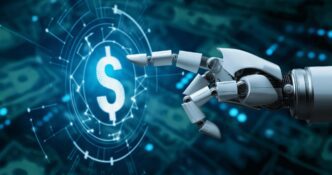As the initial frenzy around generative AI begins to settle, 2025 is shaping up to be the year of strategic implementation, where businesses globally move beyond experimentation to embed artificial intelligence deep into their core operations. The dominant trends for the coming year will focus on enterprise-grade generative AI creating tangible value, hyperautomation transforming workflows, and multimodal AI systems beginning to understand the world with human-like nuance. This shift will be underpinned by a critical, non-negotiable focus on AI trust and security, while the continued democratization of AI through low-code platforms will empower a wider range of employees to innovate, ultimately separating the market leaders from the laggards in the new AI-powered economy.
The Enterprise-Grade Generative AI Revolution
While 2023 and 2024 were characterized by widespread public experimentation with large language models (LLMs), 2025 will be defined by their targeted, secure, and specialized application within the enterprise. The novelty is wearing off, and the demand for measurable return on investment (ROI) is taking center stage. Companies are no longer satisfied with generic chatbots; they are demanding AI that understands their specific business context, data, and workflows.
Beyond Chatbots: The Rise of Specialized Agents
The most significant evolution in generative AI for 2025 is the move from general-purpose models to highly specialized, fine-tuned AI agents. These are not one-size-fits-all solutions but are trained on proprietary company data and tailored for specific, high-value tasks. This process, often involving Retrieval-Augmented Generation (RAG), allows the AI to access and utilize a company’s internal knowledge base securely.
Imagine a legal department using a generative AI agent trained on decades of its own case law and contracts to draft initial discovery requests with 90% accuracy. Consider a pharmaceutical company deploying an agent that analyzes molecular data and published research to suggest novel drug discovery pathways. These are not futuristic concepts; they are the practical applications driving business value in 2025.
The Economic Impact: Productivity and New Business Models
The primary driver for this trend is a clear economic one. Specialized AI agents are proving to dramatically boost productivity. Software development teams are using AI co-pilots to write, test, and debug code faster, reducing development cycles by weeks or even months. Marketing departments are automating the creation of hyper-personalized campaign materials, tailored to individual customer segments.
Beyond internal efficiency, this maturation is spawning entirely new business models. Consulting firms are offering AI-powered strategic analysis as a service, while media companies are using generative AI to create synthetic content for niche markets. The focus has shifted from simply cutting costs to actively generating new revenue streams powered by proprietary AI capabilities.
Hyperautomation: The AI-Driven Digital Workforce
Hyperautomation is the idea that if a business process can be automated, it should be. In 2025, AI will become the central nervous system of this movement, elevating it from simple task automation to the intelligent orchestration of complex, end-to-end business workflows. It represents a disciplined, holistic approach to creating a true digital workforce that complements human employees.
This is not just an evolution of Robotic Process Automation (RPA). Hyperautomation integrates a suite of technologies, including AI, machine learning, process mining tools, and low-code platforms. AI provides the decision-making “brain,” while RPA and other tools act as the “hands” to execute the tasks across different systems.
From Back Office to Front Line
Previously, automation was largely confined to back-office functions like data entry or invoice processing. In 2025, AI-powered hyperautomation is moving to the front line, directly impacting customer experience and strategic operations. For example, in supply chain management, AI can now monitor global weather patterns, shipping lane traffic, and geopolitical news in real-time.
If the AI predicts a potential disruption at a key port, it can automatically trigger a series of actions: rerouting shipments, updating inventory levels across all systems, notifying affected customers with a revised delivery date, and even initiating an insurance claim. This level of proactive, intelligent automation was simply not possible before the convergence of AI with other automation technologies.
Beyond Text: The Dawn of Multimodal AI
For years, business AI has primarily operated in the realm of text and structured data. The next frontier, arriving in force in 2025, is multimodal AI. These advanced models can simultaneously process, understand, and generate content from a diverse range of inputs, including text, images, audio, and video. This allows AI to perceive and interact with the world in a much richer, more contextual way.
Pioneering models from tech giants have demonstrated the ability to watch a video, listen to the audio, read on-screen text, and provide a comprehensive summary or answer nuanced questions about the content. This capability is now moving from the research lab into practical business tools.
Practical Business Applications
The applications for multimodal AI are vast and transformative. In retail, a customer could upload a photo of a living room, and a multimodal AI could identify the style, suggest complementary furniture from the store’s catalog, and even generate a new image showing how the items would look in that exact room.
In manufacturing, a system could analyze live video from the factory floor while simultaneously listening for anomalous sounds from machinery and cross-referencing sensor data. This holistic understanding allows it to predict maintenance needs with far greater accuracy than any single-input system. In healthcare, a multimodal AI could analyze a patient’s X-ray (image), the radiologist’s notes (text), and the patient’s verbal description of their symptoms (audio) to provide a more robust diagnostic aid to the physician.
AI TRiSM: Building Guardrails for Growth
As AI systems become more powerful and autonomous, the need for robust governance becomes critical. 2025 will see a massive push toward implementing frameworks for AI Trust, Risk, and Security Management (AI TRiSM). This isn’t about stifling innovation; it’s about creating the necessary guardrails to ensure AI is used responsibly, ethically, and securely, thereby building the trust required for widespread adoption.
Organizations are quickly realizing that a single major AI failure—whether due to biased outputs, a data privacy breach, or a security vulnerability—can cause catastrophic reputational and financial damage. AI TRiSM provides a structured approach to mitigating these risks throughout the AI model’s lifecycle.
The Pillars of AI TRiSM
AI TRiSM is built on several key pillars. Explainability (XAI) involves using techniques to make “black box” models more transparent, so businesses can understand why an AI made a particular decision. ModelOps applies the rigor of DevOps to the AI world, ensuring that models are reliably and consistently monitored, updated, and governed once they are deployed.
Crucially, it includes proactive measures for fairness and bias mitigation, where models are continuously tested to ensure they are not producing discriminatory outcomes. This is coupled with robust data privacy and security protocols to protect the sensitive information used to train and operate the models. With regulations like the EU AI Act setting new global standards, having a formal AI TRiSM framework is shifting from a best practice to a legal necessity.
AI for Everyone: The Low-Code and No-Code Revolution
The final, and perhaps most democratizing, trend for 2025 is the explosion of low-code and no-code AI platforms. These tools are breaking down the barriers to AI development, allowing employees without formal data science or programming backgrounds—so-called “citizen developers”—to build and deploy their own AI-powered solutions.
Using intuitive, drag-and-drop interfaces and pre-built AI modules, these platforms empower business users to solve their own problems. This drastically reduces the reliance on over-burdened central IT and data science teams, accelerating the pace of innovation across the entire organization.
Empowering the Citizen Developer
This trend empowers the people who know the business problems best to create the solutions. A sales manager could build a simple app that uses AI to analyze sales call transcripts and identify the most effective talking points. An HR professional could create a tool to screen resumes for key skills and experience, flagging the most promising candidates automatically.
By placing AI tools directly in the hands of business users, companies can foster a bottom-up culture of innovation. It allows for rapid prototyping and deployment of custom applications that address niche challenges, which might otherwise be too small to warrant the attention of a full development team. This democratization is key to embedding AI thinking into every facet of the business.
Conclusion
The year 2025 marks a pivotal transition for artificial intelligence in the business world. The conversation is shifting from the theoretical potential of AI to its practical, strategic deployment for measurable results. The enterprises that will thrive will be those that embrace specialized generative agents, leverage hyperautomation to build a digital workforce, harness the contextual power of multimodal systems, and do it all within a rigorous framework of trust and security. By simultaneously empowering their entire workforce through accessible low-code tools, these leading organizations will not just be using AI; they will be fundamentally reshaping their operations and competitive landscape around it.








